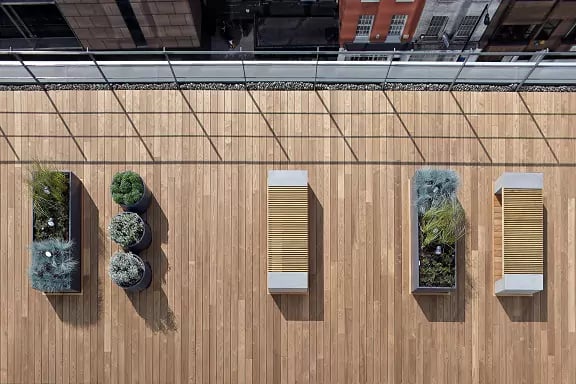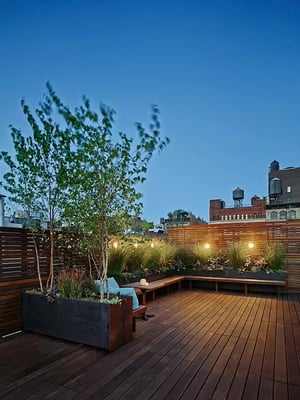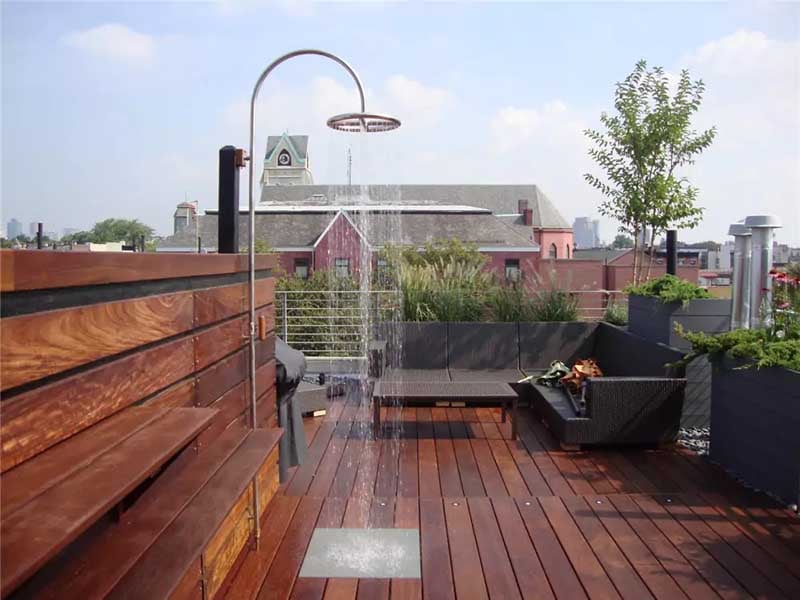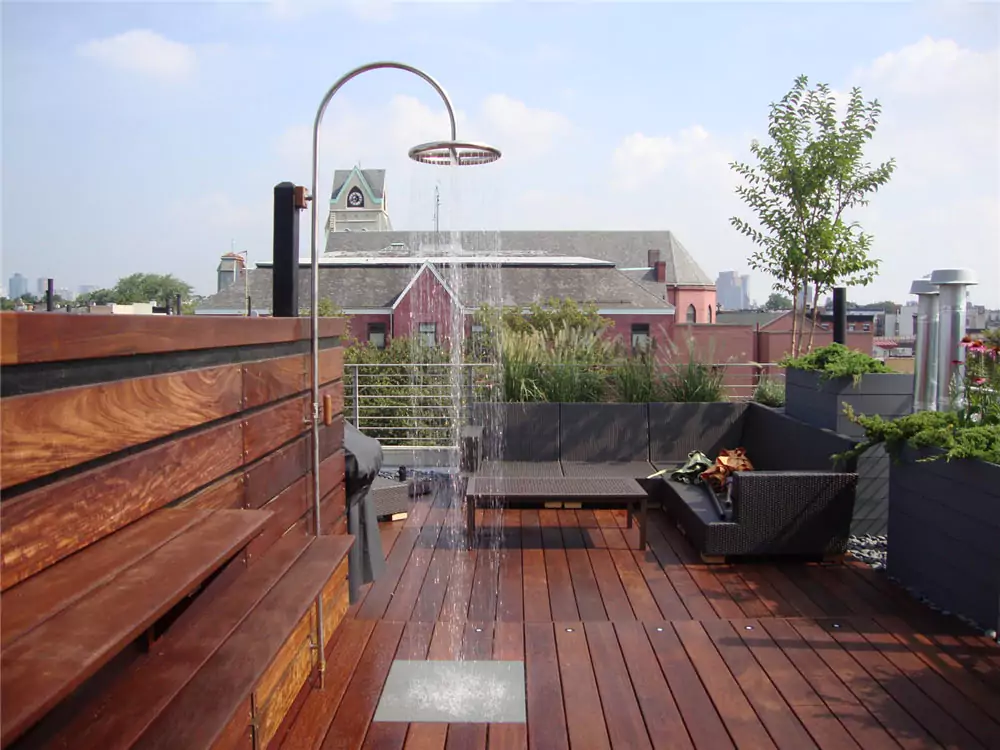
A rooftop deck can be like taking a vacation without ever leaving your home. Many homes and buildings with flat roofs can qualify for a roof deck. But not all. See if your home or building qualifies for a rooftop deck. Get some great tips and rooftop deck ideas.
Discover the Allure of a Wood Rooftop Deck
A rooftop deck creates a unique space unlike any other. You’re outdoors, yet you are still home. Aah, the fresh air. Panoramic view. Privacy. Getting away from it all. It’s like being on a mountaintop, except much easier to get to. Just a few steps away and you are there. Enjoy the freedom.

Ipe wood rooftop deck with planters, bench seating and privacy screening
A roof deck also creates additional living space. Outdoors. And at a fraction of the expense that creating additional indoor living space would cost. A home addition often costs upwards of $200/per square foot. Usually more. A rooftop deck costs a fraction of that. Closer to $25 - $35 per square foot. Adding a roof deck adds to the enjoyment of your home, at a significant savings.
Financially, a standard deck usually recoups at least 80% of its overall cost when reselling a home or property. But rooftop decks often pay back more than 150% of their initial costs. So, you can benefit financially when selling your property and enjoy the benefits of the roof deck while you live there. If the space is already there, and you're wasting it, why not take advantage of it?
In practice, though, a rooftop deck often becomes a major selling point of the property. It is sometimes the key deciding factor to which property a buyer selects to purchase. So, a rooftop deck improves your lifestyle, expands your living space, costs far less than an addition and gives you a major payback when you sell your property. What’s not to love?

Garapa hardwood decking on a walkout rooftop deck
Inspiring Wood Rooftop Deck Ideas to Ignite Ideas
If you think you’d like to move forward with a rooftop deck, you probably have some ideas what you’ll use it for. Is it for entertaining? Relaxation? Dining? Yoga? Reading? Bird watching? Whatever your planned activities and uses for your roof deck are, there are great ways to design your deck. Do some online searches for rooftop deck ideas. Here are a few places to check:
RELATED: Check out our Rooftop Deck Project Pictures Gallery
Weighing Your Options: Understanding Rooftop Load and Design Considerations for Wood Decks
First, check with the local authorities and experts. Building inspectors can be very helpful here. Check zoning rules and find out if building a roof deck is allowed in your area. If you are allowed to build a rooftop deck in your area, the next step is to see if your roof is in good shape and find out if it can take the load.
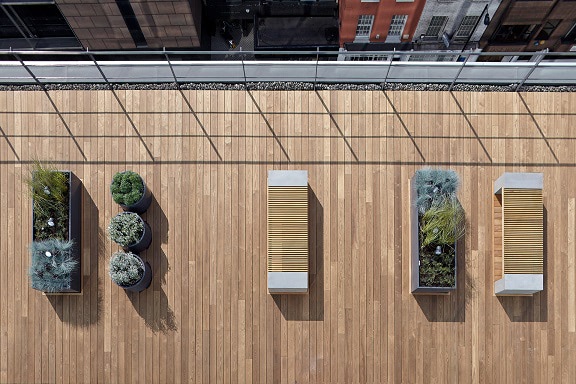
Thermally Modified Ash decking for rooftop deck
Finding out how much weight your roof deck can support is critical. It affects everything. It affects the number of items you can place on your deck. Planters, furniture, fire pits, bars, benches, and other accoutrements all weigh a certain (and measurable) amount of weight. People do too.
With a typical residential wood deck, 50 to 60 pounds per square foot covers the weight that most furniture, people and small accessories will add. Now the question is, ‘how much weight will my roof support?’ Your roof must support, at minimum, at least as much as your deck weighs plus its maximum design load. To find out if your existing roof can support the extra weight of a rooftop deck will likely require an experienced builder, an architect, or an engineer.

Ipe hardwood rooftop deck in NYC with heavy planters, built-ins and more
If you are considering heavier items for your roof deck, you will need to plan accordingly. Hot tubs, spas, heavy furniture, pergolas, and large planters are a few examples of heavy objects whose weight needs to be accounted for in your design. Your engineer should be able to help here.
Designing Creativity in Your Wood Rooftop Deck Layout
Okay. So now you have found out that your roof can handle the load of a deck. Check. You have some ideas of what you will be using your deck for. Check. You probably have an idea of many of the items you’d like to place on your deck. Planters? Furniture? Privacy screening? Fire Pit? Bar? Seating? How about an outdoor kitchen or cooking area? Benches? Any built-ins?
 Garapa hardwood deck featuring built-in benches, fireplace, planters and privacy wall
Garapa hardwood deck featuring built-in benches, fireplace, planters and privacy wall
It’s showtime. Dream away. To get started, some people like to draw a scale model of their deck and then cut out to-scale pieces of furniture. You can arrange them and rearrange them to your heart’s content. Have some fun.

You may want to hire an architect or designer. They are excellent with space planning. Experienced roof deck builders are also a great option. They can often design and build your deck. They have likely already learned what works best. And what doesn’t work. Why risk making mistakes when you have experienced guidance readily available?
Choosing the Best Framing Materials for Your Wood Roof Deck
By now, you have a good idea of your roof deck layout. And how you’d like to position all your furniture, built-ins, etc. It’s time to choose some materials to build your roof deck. Let’s start at the bottom of the deck. How are you going to frame it? The basic roof deck framing options are sleepers, pedestals and deck tiles, wood framing, or aluminum framing.
Sleepers vs. Pedestals: Understanding Wood Rooftop Deck Framing Choices
You can use sleepers. The downside of using sleepers is threefold. Sleepers may impede the flow of water. If so, always run your sleepers parallel to the flow of water. Secondly, wood sleepers tend to rot. It’s really just a matter of time. And thirdly, sleepers are exceptionally low clearance.
 Here, the sleepers rotted first and the decking soon followed
Here, the sleepers rotted first and the decking soon followed
The lower your decking clearance, the moister the underside of the decking is. The more moisture under the deck, the more likely it is you’ll have problems. Deck boards may cup, twist, or rot.
Deck Pedestals and Deck Tiles
Using adjustable deck pedestals with pre-made wooden deck tiles is a simple, lower cost option.

Ipe hardwood deck tiles on rooftop deck in Rhode Island
Conventional Deck Framing Lumber
Using conventional pressure treated framing lumber for a deck is an option, too. For pitched roof decks, it may be your best option. In other situations, framing lumber might not be your best option. For example, the height of the framing lumber might be too high to meet your deck’s needs.

The pitch of this roof was too steep for other rooftop deck framing methods, so pressure treated framing lumber and posts were used
The downside of using PT lumber for roof deck framing is that rooftops are a very exposed and harsh environment. Pressure treated lumber may twist, warp, or split up here. The additional weight of the framing lumber may or may not work on your deck.
Aluminum Joists and Deck Pedestals
Aluminum rooftop deck joists like the Eurotec EVO system are lightweight, strong, fire resistant, will not warp or twist, and are always straight and true. The adjustable deck pedestals allow you to make your deck frame perfectly level.

Eurotec EVO Aluminum rails are black for low visibility. Adjustable pedestals ensure the entire deck surface is level.
Wood Rooftop Decking Material Options
Way up on a rooftop, the sun shines bright, the rains drive hard, and it is fully exposed to all the elements. 'Ain't no hiding place' up there. Many decking materials cannot survive these extremes. Plastics and composites can fade and warp. Pressure treated decking will check and may split. Softwoods like cedar decking will have to be painted or stained regularly to survive the brutal forces.
Hardwood decking performs best in this unforgiving environment. Wood decking species like Ipe, Machiche, Jatoba and Garapa can handle the weather conditions exceptionally well. Thermally modified wood decking can take the punishment, too.
Ipe hardwood decking is widely prized for its strength and durability.
Machiche hardwood decking is FSC Certified, beautiful, strong, durable and budget friendly
 More Info about FSC Machiche Decking
More Info about FSC Machiche Decking
Machiche Wood Deck Picture Gallery
Garapa hardwood decking is another good option for a roof deck. it can handle the elements.

More Info about Garapa Decking
Garapa Wood Decks Picture Gallery
Thermally Modified Wood Decking is another durable decking option that can handle the rigors of a rooftop environment.

Eurotec Rooftop Deck Installation
For wood rooftop decks, the Mataverde Eurotec System is a game changer. The system itself is strong, lightweight, and extremely durable. Because the pedestals are adjustable, your deck will be perfectly level. The pedestals distribute the weight of the deck evenly over the roof safely.
Check out this video and see how easy it is to install the Eurotec deck system:
More information about the Eurotec Roof deck System
Are you ready for rooftop deck pricing? Request a Eurotec Rooftop Deck Quote.

Related Posts
